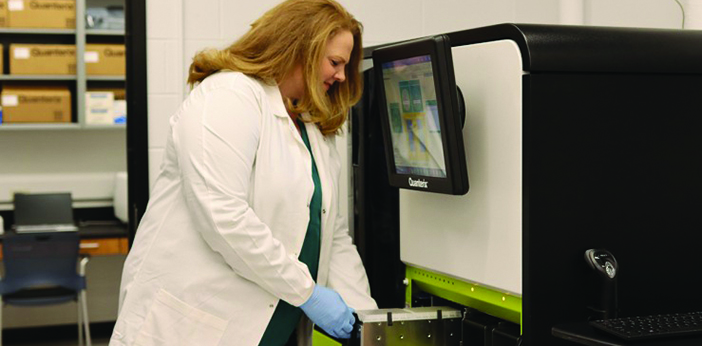Carney Institute scientists study blood samples for biological signals of dementia, expanding the possibilities of brain research.
Inside a quiet, tucked-away lab in Brown University’s Biomedical Center sits an unassuming machine that, in the right hands, is helping unlock the secrets of the brain—specifically Alzheimer’s disease and related dementias.
With its clean lines and neon-colored panels, the machine resembles a futuristic refrigerator. It’s actually a technologically advanced piece of laboratory equipment whose immunoassay analyzer detects biomarkers that—when combined with other tests—can serve as biological red flags for neurological conditions like Alzheimer’s.
Detection of biomarkers like these may make possible earlier diagnosis of Alzheimer’s, enabling patients to seek treatment even before they experience symptoms, says Kristine Pelton, the director of the Carney Institute for Brain Science’s Center for Alzheimer’s Disease Research Fluid Biomarkers Laboratory. The brand-new facility is helping to transform fluid biomarker-based research at the University, the state, and the region, she says.
“A non-invasive, reproducible, and cost-effective way to detect and measure biomarkers is a game-changer for the field and for patients,” says Pelton, who notes that biomarkers will also allow researchers to monitor subtle changes in patients’ conditions over time, which can help them fine-tune treatment plans.
It’s very difficult to measure biomarkers for Alzheimer’s, which are generated by the central nervous system and found in cerebrospinal fluid and, in lesser concentrations, blood. The standard procedures involve a lumbar puncture (also known as a spinal tap)—which is time-consuming, expensive, and painful for patients. Biomarkers can also be measured through imaging tests like an MRI or a PET scan, but these tests are not easily accessible for most people.
But technology has been advancing to the point that immunoassay analyzers can now look for biomarkers in blood, which is much easier to obtain.
“If a doctor can order a simple blood test, the number of people that we can reach within our communities increases dramatically,” Pelton says. “In addition, by perfecting these blood-based biomarkers, we could potentially diagnose patients earlier when treatment interventions for neurodegeneration have a better chance at improving outcomes.”




